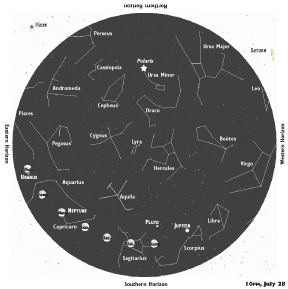The Many Moons of July
Old names still ring true
The waxing moon arcs through southern skies, reaching full phase Sunday when it shines dusk to dawn. From culture to culture, July’s full moon comes with many names. Some are clear and others beg elaboration. But at one time, these names were another generation’s Old Farmer’s Almanac.
Native Americans aptly called this the Red Cherries Moon and, despite our drought, the Thunder Moon.
Along with honeybees, European settlers brought us the Mead Moon, which dates to medieval times. This is when the bees most amply provide the main ingredient for this honey-based drink. Europeans also brought organized agriculture, and a drive through pastureland, with bales and rolls of winter livestock feed curing in the sun-soaked fields, explains the Hay Moon.
But the Buck Moon? Around the globe and across species, all male deer shed their antlers in the spring and begin to sprout their next set in the midsummer days of July. Reindeer follow a different drummer. Both male and female sport and shed antlers.
Over the years, other bucks grow larger and more branched racks. A big set of antlers offers two benefits: it attracts more mates, increasing the buck’s progeny; the antlers also determine status, both visually and in combat with other bucks, thus allowing the biggest and strongest to choose the most mates.
But there’s a catch: A large rack of antlers can be fatal to the buck, lodging in branches or even intertwining with rival’s rack while fighting. So after the winter mating season, the bucks shed their antlers. Within only a few weeks the new set emerges, growing larger and more branched each year, thus, allowing the bucks that survive another year to climb in status.
Tidelog®
Illustration: © Copyright 1925 M.C. Escher/Cordon Art-Baarn-Holland; Graphics: © Copyright 2007 Pacific Publishers. Reprinted by permission from the Tidelog graphic almanac. Bound copies of the annual Tidelog for Chesapeake Bay are $14.95 ppd. from Pacific Publishers, Box 480, Bolinas, CA 94924. Phone 415-868-2909. Weather affects tides. This information is believed to be reliable but no guarantee of accuracy is made by Bay Weekly or Pacific Publishers. The actual layout of Tidelog differs from that used in Bay Weekly. Tidelog graphics are repositioned to reflect Bay Weekly’s distribution cycle.Tides are based on National Oceanic and Atmospheric Administration and are positioned to coincide with high and low tides of Tidelog.
